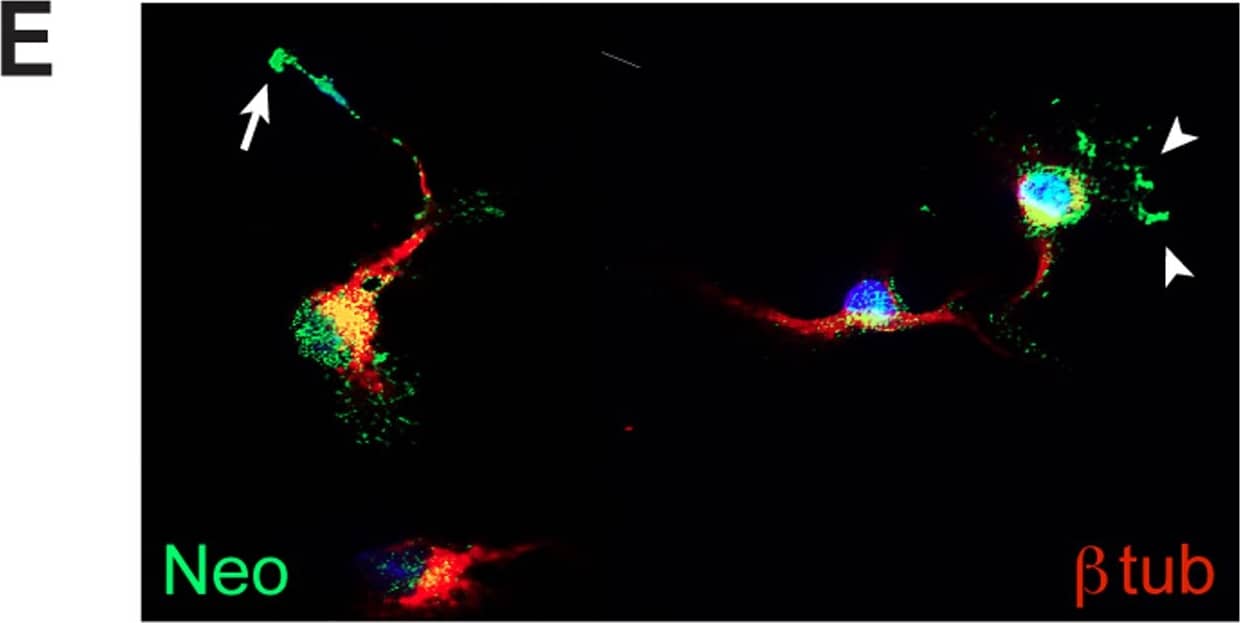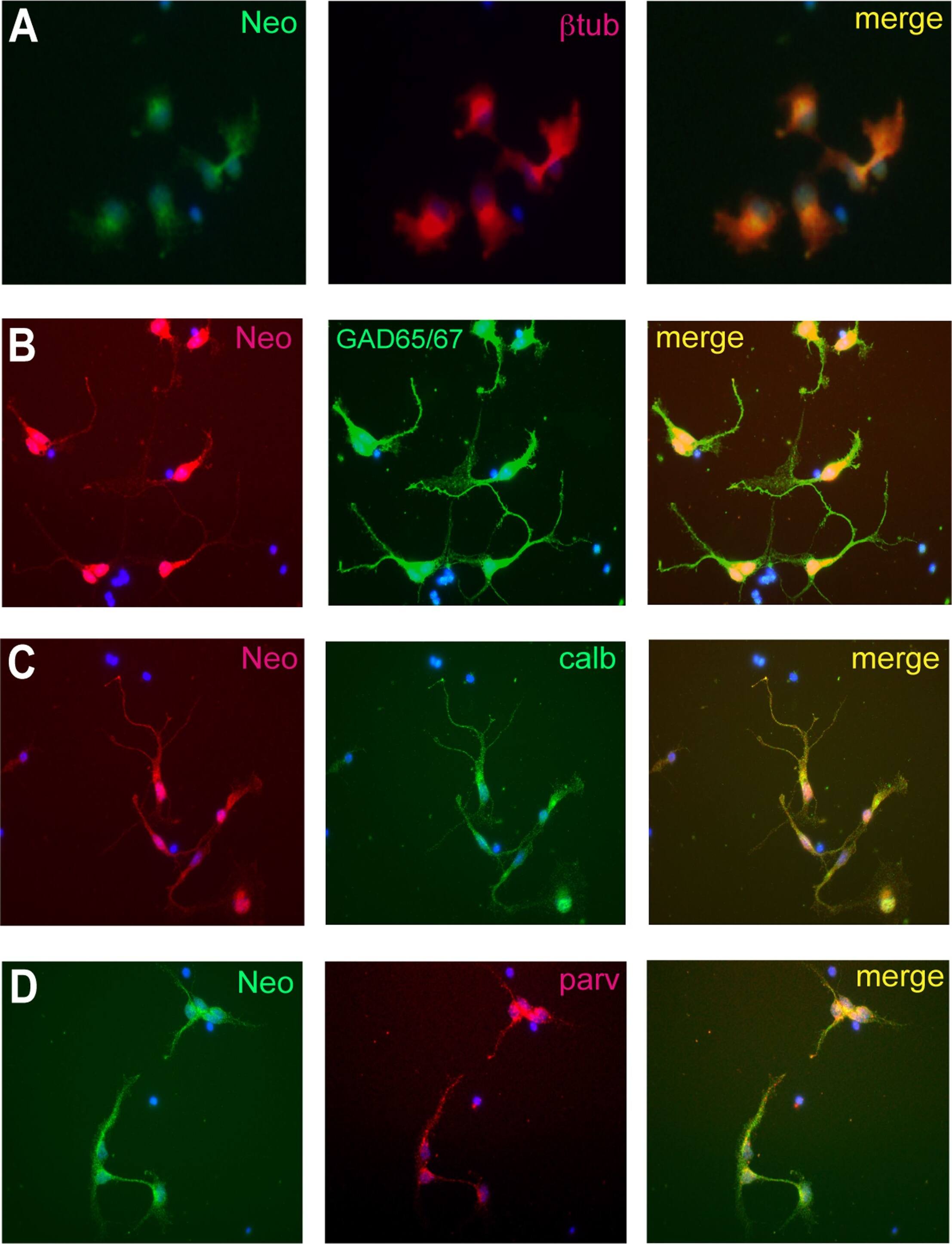Mouse Neogenin Antibody
R&D Systems, part of Bio-Techne | Catalog # MAB1079

Key Product Details
Species Reactivity
Validated:
Cited:
Applications
Validated:
Cited:
Label
Antibody Source
Product Specifications
Immunogen
Ala42-Ile1033 (Asp442-Leu461 del)
Accession # NP_032710
Specificity
Clonality
Host
Isotype
Scientific Data Images for Mouse Neogenin Antibody
Detection of Mouse Neogenin by Immunocytochemistry/Immunofluorescence
Neo is expressed on newborn cortical interneurons and the maturing calbindin and parvalbumin subpopulations.(A) 2 day cultures from the E14.5 MGE were immunolabeled with anti-Neo (H-175, green) and anti-beta III-tubulin (red; merge, yellow), a marker for newborn neurons. (B,C,D) MGE cells were isolated at E14.5, differentiated for 4 days and then colabeled with (B) anti-Neo (MAB1079, red) and anti-GAD65/67, a GABAergic interneuron marker (green; merge, yellow), (C) anti-Neo (MAB1079, red) and anti-calbindin (green; merge, yellow), or (D) anti-Neo (H-175, green) and anti-parvalbumin (red; merge, yellow). Image collected and cropped by CiteAb from the following publication (https://pubmed.ncbi.nlm.nih.gov/24312340), licensed under a CC-BY license. Not internally tested by R&D Systems.Detection of Mouse Neogenin by Immunocytochemistry/Immunofluorescence
RGMa promotes neurite extension in differentiating interneurons.(A) E14.5 GE cells were differentiated for 4 days in the presence of 0–400 ng/ml RGMa and neurons labeled with anti-beta III-tubulin. (A) There was no significant difference in the total number of neurites elaborated per neuron in the presence of RGMa. (B) Addition of the inhibitory peptide Pep2 (10 µM), or control peptide ScPep (10 µM), had no significant effect in the presence (400 ng/ml) or absence of RGMa. Number of neurons counted per condition >520. (C) A significant increase in neurite length was observed in the presence of 400 ng/ml RGMa. RGMa-induced outgrowth was abrogated by Pep2 (10 µM) but not ScPep (10 µM). Number of neurons counted per condition >520. **p<0.01. (D) RGMa (400 ng/ml) did not enhance axon length (longest neurite). Number of axons counted per condition >90. (E) Colabeling of differentiating interneurons with anti-Neo (H-175, green) and anti-beta III-tubulin (red) showed Neo concentrated in the filopodia of neurites extending from the cell body (arrowheads) and in growth cone (arrow). Image collected and cropped by CiteAb from the following publication (https://pubmed.ncbi.nlm.nih.gov/24312340), licensed under a CC-BY license. Not internally tested by R&D Systems.Applications for Mouse Neogenin Antibody
Western Blot
Sample: Recombinant Mouse Neogenin Fc Chimera (Catalog # 1079-NE)
Formulation, Preparation, and Storage
Purification
Reconstitution
Formulation
Shipping
Stability & Storage
- 12 months from date of receipt, -20 to -70 °C as supplied.
- 1 month, 2 to 8 °C under sterile conditions after reconstitution.
- 6 months, -20 to -70 °C under sterile conditions after reconstitution.
Background: Neogenin
Neogenin (NEO) is a type I transmembrane protein that is crucial for axonal guidance and neuronal migration. It is also involved in regulating differentiation programs in many embryonic and adult tissues (1). Mouse NEO is widely expressed in adult tissues and is expressed throughout the mid to late stages of gestation, in both neuronal and non-neuronal tissues. It is a member of the immunoglobulin (Ig) superfamily and is closely related to deleted in colorectal cancer (DCC). Mouse NEO cDNA encodes a 1493 amino acid residue (aa) precursor with a putative 36 aa signal peptide, a 1100 aa extracellular domain with six Ig-like C2 type domains and three fibronectin type III domains, a 21 aa transmembrane domain, and a 345 aa cytoplasmic domain. At least five isoforms are produced in mice by alternative splicing. Mouse NEO shares 96%, 93%, and 86% aa sequence identity with rat, human, and chicken NEO, respectively. It also has 46% and 29% sequence homology with mouse DCC and C. elegans UNC40, a homolog of DCC. NEO and DCC, together with the UNC5 family of type I transmembrane proteins, are receptors for the netrin/UNC6 family of laminin-related bifunctional guidance molecules that both attract some axons and repel others (2, 3). In mouse, at least five netrins (netrin‑1, ‑3, -4, G1, and G2) have been identified (3-5). Mouse netrin-1 and netrin-3 have been shown to be ligands for mouse NEO.
References
- Keeling, S.L. et al. (1997) Oncogene 15:691.
- Hong, K. et al. (1999) Cell 97:927.
- Livesey, F.J. (1999) Cell Mol. Life Sci. 56:62.
- Nakashiba, T. et al. (2000) J. Neurosci. 20:6540.
- Nakashiba, T. et al. (2002) Mech. Dev. 111:47.
Alternate Names
Gene Symbol
UniProt
Additional Neogenin Products
Product Documents for Mouse Neogenin Antibody
Product Specific Notices for Mouse Neogenin Antibody
This product or the use of this product is covered by U.S. Patents owned by The Regents of the University of California. This product is for research use only and is not to be used for commercial purposes. Use of this product to produce products for sale or for diagnostic, therapeutic or drug discovery purposes is prohibited. In order to obtain a license to use this product for such purposes, contact The Regents of the University of California.
U.S. Patent # 5,939,271, 6,277,585, and other U.S. and international patents pending.
For research use only

